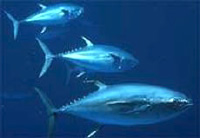For two weeks after Japan’s Fukushima Dai-ichi powerplants were damaged by an earthquake and subsequent tsunami on 11 March 201l, large quantities of radioactivity leaked directly from the plants into the Pacific Ocean. A new study by scientists from Stanford University’s Hopkins Marine Stationand Stony Brook University’s School of Marine and Atmospheric Sciences (SoMAS) has revealed that Pacific bluefin tuna (Thunnus orientalis) carried Fukushima-derived radioactivity from Japanese waters to the waters off California. Their study has just been published in Proceedings of the National Academy of Sciences of the US. SoMAS professor Nicholas Fisher and postdoctoral scholar Zofia Baumann and Daniel Madigan of Stanford measured the levels of two radioactive isotopes of cesium in bluefin tuna caught in August 2011 off the coast of San Diego, California. Pacific bluefin tuna spawn in the western Pacific and many migrate in their first or second year to the waters of the eastern Pacific. The authors found that the sampled fish contained elevated levels of radioactive cesium-134 and cesium-137 compared to Fukushima bluefin which migrated from Japan to California before the Fukushima disaster. The team found no evidence of Fukushima-derived radioactivity in yellowfin tuna (Thunnus albacares), also caught in August 2011 off San Diego, which is a residential species that did not cross the Pacific Ocean. Both cesium isotopes were important components of the radionuclide mix released at Fukushima. Only trace levels of cesium-137, whose half-life is 30 years, had been detectable in water and biota prior to the disaster, primarily a remnant of prior nuclear weapons testing, and cesium-134 (half-life of 2 years) had been undetectable in seawater and biota in the Pacific before the Fukushima disaster. The authors concluded that the source of the radioactivity found in post-Fukushima bluefin tuna off the California coast was the Fukushima release.
The authors emphasized that the elevated levels of cesium isotopes in Fukushima-exposed migratory bluefin tuna caught in August 2011 almost certainly do not pose public health concerns. By the time these fish arrived in California, the artificial radioactivity levels in these fish were more than twenty times lower than the Japanese safety limit and over thirty times lower than the naturally-occurring potassium-40, another gamma-emitting radioisotope which is present in all marine biota. The full extent of the public health threat of this radioactivity remains unknown. Fisher cautions, “The radioactivity levels in bluefin tuna caught in California in August 2011 were only about 3% above the natural background radioactivity. Levels in this year’s bluefin may be higher, as they would have been exposed to radioactive food and water for about one year prior to migration, unlike in 2011 when they were exposed for only about one month. However, radiocesium concentrations have become diluted and dispersed since the disaster occurred,so the public health aspects will remain unclear until this year’s tuna are analyzed. We are now preparing to do that.”
These findings represent the first documented instance of the transport of radioactive materials in the sea through a biological migration. Analyzing the radionuclide content in top marine predators such as bluefin tuna should provide unequivocal evidence of migratory routes and timing of these animals. Such information would complement other migratory tracking tools and be useful for management and conservation of key fisheries and possibly other endangered species. The findings also demonstrate the interconnectedness of distant ecoregions, where events in one can be linked to findings in another region, even thousands of miles away.
Commenting on these findings, Madigan stated, “From a terrible event, we have found what should prove to be a very useful tool to examine migratory patterns of Pacific bluefin tuna and many other important species in the Pacific Ocean. These (findings) also provide a clear example of nature simply being amazing. Radiocesium made it to California not by wind or ocean currents, but packaged in the muscle of a fish species that swims across the biggest ocean on the planet.”
This research was funded by the Gordon and Betty Moore Foundation of San Francisco, California.







You must be logged in to post a comment.